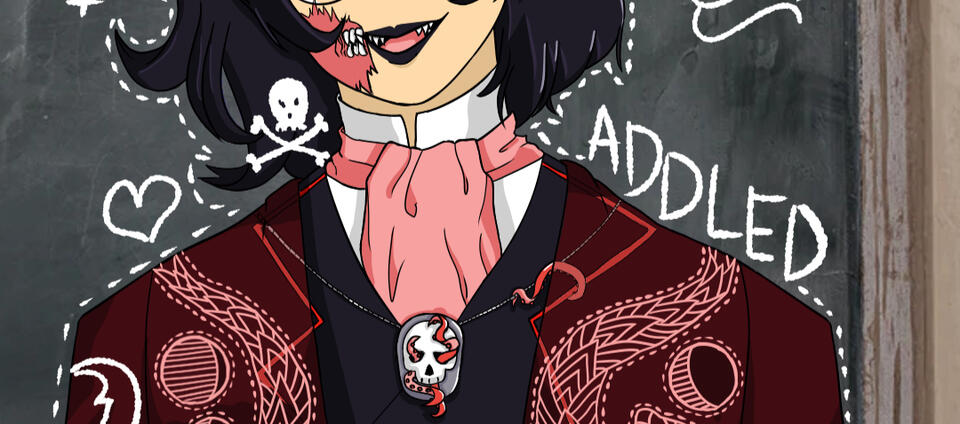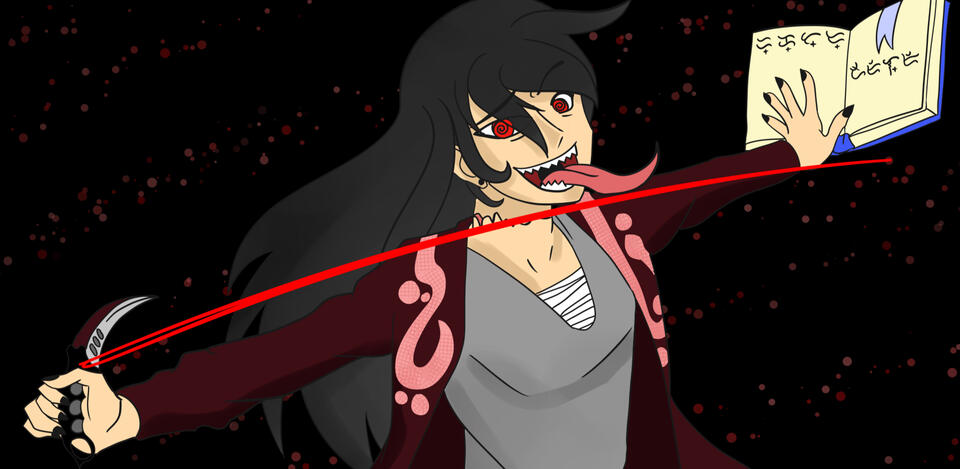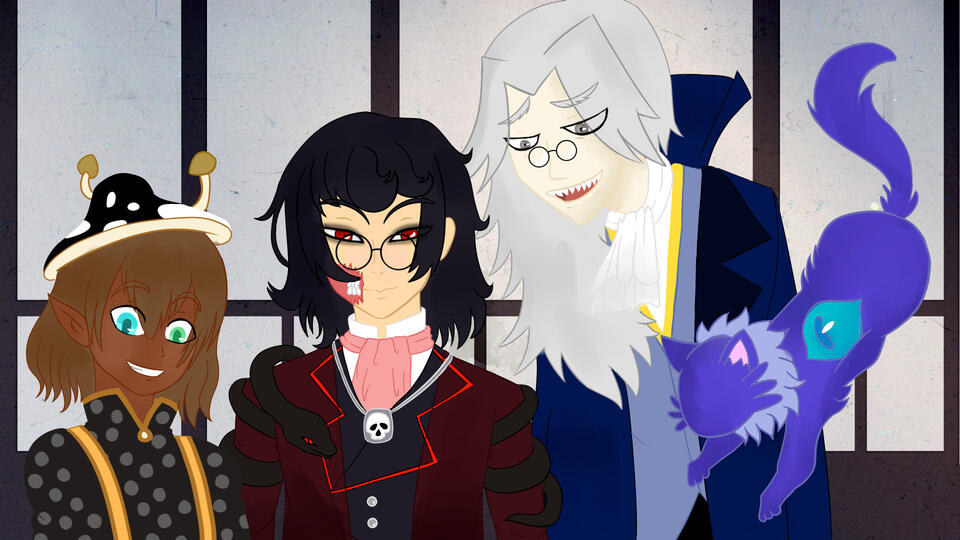
Addled Doctor
Mangkukulam Extraordinaire, Deity in the Making
History

Nickname(s): Doctor, AD
Age: 720 Years Old
Birthday: 8th of March
Height: 5'7" (170cm)
Gender: Genderfluid AFAB
Sexuality: Poly-Pan
Disclaimer: The Philippine tribe described in this history is purely fictional. The Manager claims no expertise of Philippine pre-colonial history, though it is a very interesting topic. The Manager wishes no disrespect to the native folk of the Philippines.
The Doctor was born in the archipelago currently known as the Philippine Republic prior to its colonization. Born as a chieftain's daughter, Naia Baybay was renowned for being a skilled healer – priestess to the seven moon deities – but was also considered unnatural due to her albinism. But the latter fact was kept hidden from her; the chieftain always told her she was kept hidden to protect her womanhood. Her life was quiet, cloistered away and protected by her parents with her only human contact coming from her family and patients who were desperate enough to seek out her healing skills.
Tired of the isolation, Naia snuck out during one of the village's moon festivals to join in the celebration. Covered in heavy cloth, she watched enamoured as the men folk dressed as women, proud in their elegance and beauty, to embrace the femininity of the moon. And a thought brewed in her head. If these men could embrace womanhood – then, certainly, she can embrace manhood as well, right?
The thought felt right to her. Not the idea that she could be a man if she wanted to be. But the idea that she could be well, whatever she wanted to be, whenever she wanted to be.
Enraptured by this revelation, she started dancing along to the festivities, uncaring that she stayed in the outskirts of the crowd. In her frenzied dance, the cloth hiding her fell away. And one of the guards on duty mistakes her for a spectre and attacks her out of fright. When the deed is done, he realizes who it is he just assaulted.
Her body is thrown out into the sea.
Battered and broken, Naia's body drifts under the moonlight, pale and unnatural. And the moon deities weep and mourn for the loss of a loyal and wonderful priestess. But they do nothing more, even as their tears form rain that push her under the waves. She drowns. And this would have been the end of the story of Naia Baybay-
But a monstrous sea serpent comes and takes her corpse away.
Bakunawa, they call themself. When she awakes, she is at awe at the deity that had saved her. Bakunawa the Moon Eater and the guardian of the Underworld found deep in the sea. They had kept her soul out of the Underworld out of pity, seeing her as another one abandoned by Bathala and the moons. She had already died – but they "undid that" was the callous admittance.
But what did it cost? What did she have to pay for her unwitting resurrection? The first: a life for a life – the Underworld was still waiting for a soul that should have been hers. Days after the fact, she finds the guard who had assaulted her and takes his life with her own hands. The second: her companionship. Bakunawa was a lonely one. And to steal a priestess from the moons for themself was a great irony. To have that priestess eventually take their place as the Moon Eater was an even greater insult.
Naia lived through the years as Bakunawa's priestess… or priest or even acolyte if she- they felt like it. They witness history side-by-side. While the people only catch glimpses of them, word of a mangkukulam – one who reeks of death and dark magick able to grant wishes – were widespread wherever they went. The name Naia eventually fades from use as they assume the title of a witch doctor gladly.
But all those years were not smooth sailing. Each year brings about its own strife and grief. The Doctor's first death would not be their last. Persecution was inevitable. Many of those deaths came during the era of the Spanish colonisation. After all, they were considered an enemy to the Biblical ideals. But after returning from the grave and gaining vengeance one too many times, the locals soon learned well enough to warn the foreigners not to anger them. Even completely destroying their body would not keep them from coming back. Not that the foreigners always listened.
The Doctor and Bakunawa kept watch, as the country was colonised by the Spaniards and the Chinese and the Americans and on and on and on. Watched as independence was achieved and president after president came into power. Though the Doctor had power to influence any of these historical events, they preferred to keep to themselves.
Happy to be the helpful if scary Doctor that listened and gave aid to those brave enough to approach them. Over the years, they've made friends, of course. And, on rare occasions, there have been lovers as well. And when the itch to travel and see the world came, they'd live for a year or five in another country before coming back to the islands Bakunawa was bound to. The serpent deity was never far away from the Doctor, after all, their very essence weaved into the cloak the Doctor wears that had once been a Barong.
For now, the Doctor resides in the Bay House. An old Spanish style villa and ancestral home that they frequent. The halls and rooms are filled with all sorts of self-proclaimed villains and monsters. And its doors are always open to those in need and those who want to help others, should they be brave enough.
Abilities

Magick: Being a mangkukulam, the Doctor is well versed in all kinds of magick. They specialize in healing and necromancy, as that is a branch of magick they've known since their childhood. Philippine sorcery comes naturally to them. But they've also studied other forms from their interactions and travels. Empathic magick, potion making and transmogrification are some of their favourite branches to employ. However, they refuse to touch serious temporal magick for a couple more centuries… or at least they've finished their ascension.
Superhuman Attributes: The Doctor has above average strength, speed, stamina and durability compared to the average being.
Shapeshifting: The Doctor can shapeshift into any form, both humanoid and non-humanoid, so long as they are still them. However, some forms are more natural than others.
Regenerative Healing Factor: Their metaphysical body allows them to survive injuries fatal for mortals and heal from them at a faster than normal rate. Depending on the level of injury though, they may require assistance from outside sources such as healers and the healing pools.
Conditional Immortality: They cannot die but must pay the price of another's soul to take their place in the Underworld while they still haven't achieved full godhood. The Doctor's built up a sizeable collection of souls in the past, however, and have no real reason to hunt down any new ones at the moment.
Path to Godhood: Being turned from a priestess to a god, the Doctor does not classify as human anymore. The path to godhood is a difficult one, however, as their body is constantly dying and regenerating in its efforts to contain all that power in their form. The Doctor is in constant pain and is often sick due to this transformation.
Naga & Moon Eater Forms: Due to their patron – Bakunawa's – origins, the Doctor can turn into a Naga or a Moon Eater. The Naga is a being who is part-person, part-snake. And their Moon Eater form can be likened to a giant serpent, great in size with a maw large enough to swallow the moon.
Serpent Tongue: The Doctor can speak to and control snakes like it is their native tongue.
Snake Skin: They can harden their skin and turn it into scales, making them tough and hardy. These scales are as tough as the average god armour yet way more flexible and can also be shed when damaged. Wearing the skin, however, makes the Doctor susceptible to extreme temperatures like an ordinary cold-blooded snake would be. This makes the snakeskin not viable in locations of extreme heat or extreme cold unless they are well-insulated beforehand. The cold makes them slow and sluggish, with forced hibernation a possibility if left alone too long. And heat can leave severe and painful burns on the skin beneath the scales, leading to cracking and bleeding.
Venom Fangs: When threatened, the Doctor can turn their very saliva acidic and venomous. Their bite, while not immediately deadly, can paralyze after it has set into their prey’s bloodstream. Prolonged exposure to their venom without an antidote can eventually damage one’s nervous system and brain, resulting in permanent paralysis, brain damage or worse.
Eskrima Mastery: They are practiced in the national martial art of their home country. Eskrima (also called Arnis or Kali) is a weapon-based fighting style that focuses on dual wielding. Weapons can range from sticks to knives and other bladed weapons, various improvised weapons such as umbrellas, and even open-handed techniques without weapons.
Relationships

Bakunawa the Moon-Eater: Their patron deity and master. Bakunawa saved the Doctor to become their priestess and to eventually take their place, once they have achieved godhood.
The Manager: The Manager is a poor, overworked mortal who assists the Doctor in their plans. They borrow the Manager's voice when talking, as the Doctor's own voice can bring curses upon those who hear it. The Manager is also responsible for handling technical issues the immortal has troubles with.
Loki the Norse Deity: Another god that the Doctor has interactions with. They get along quite well together. And when the trickster is bored, he makes music for the Doctor.
Deceased Family: The Doctor has had their own blood family in the past. Spouses, children, grandchildren and so on. But the Doctor has watched them all grow old and die, staying behind. The souls of their loved ones are kept in the Bay House.
Eyecat: They met while the Doctor was traveling and went through a life and death experience together. Ever since then, they've been thick as thieves. And while most might think the two are merely master and pet, there's more to the relationship between them than meets the eye.
Alistair Verdun: A fellow immortal; the Doctor and the Librarian have a weird love-hate relationship but may very well be the best of friendly rivals due to similar circumstances. While they like to tease each other, they have each other's back. He stays in order to prevent the Doctor from unleashing pandemonium, should they lose their sanity and control over their budding god powers.
Cordycipitaceae Imperatrix: Cordy is someone the Doctor cherishes and is amazed by, due to the fungi's interesting capabilities. The Doctor trusts Cordy to help them with their overloaded body, allowing her to consume from their deceased body to prevent any unfortunate accidents from occurring.
The Ethereal: A god-entity that can match the Doctor, they have a healthy respect for the being of knowledge. That, of course, doesn't stop them from joking and flirting around with the Ethereal when he chooses to possess Alistair.
Lia'del Yuli: A young maiden the Doctor rescued from an academy of servants, bought and employed to be the Head Maid of the Bay House. They care for the young girl, seeing some of themselves – of Naia – in Lia.
Renzy the Blood Slime: The Doctor senses great things from the unassuming little slime and treats them like one would a child.
Breston O'Brian: The Doctor has no strong feelings for the man that made himself butler of the Bay House but doesn't begrudge the free labor.
Yukirochisu: Found digging through the Bay House's things, the Doctor keeps the raccoon as an archivist, just to see what another makes of things around the place.


